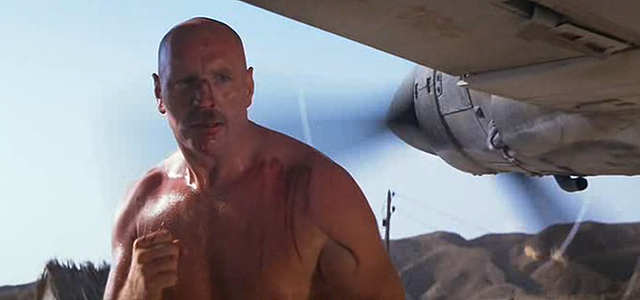Let’s talk about Indiana Jones for a bit.
Now, from a storytelling perspective, it might look like an arbitrary combination of cool bits. “Archeologist” + “whip” + “Nazis” + “traps” + “John Williams theme” = a franchise. But it goes a little bit further than this – there is a train of thought at work here. He’s not just an action hero – Indy is an archeologist, and that is not neutral. He’s a man that literally walks through history – a time-traveler, albeit a rudimentary one. A man that acts as an arbiter in the confrontation between “good” and “evil” sides of history. Because that’s an interesting point with these movies – he never actually defeats the bad guy. “Raiders of the Lost Ark” and “Temple of Doom” both end with the antagonist executed by divine intervention, be that deity the Old Testament God or Shiva. “The Last Crusade” has the two evil guys dying because of their own greed and desire for riches and power, trying to seize the Grail no matter what. The Icons of ancient history are given new power to defeat another historical icon: because those movies are ideologically iffy as fuck, sometimes it is the Bad Native, the primitive sorcerer. But most of the time it’s the Nazis. Pop culture does so love a good Nazi. It’s just fact. HYDRA, the Red Skull, Hans Landa – that stuff sells. They’re a useful tool in terms of storytelling – they are so abject, so over-the-top in their evil that you can basically go anywhere with them and still not break the reader’s suspension of disbelief. Magician Nazis, Mecha-Nazis, whatever. It’s no coincidence that the rise of the classic FPS game, with a healthy dose of blood and guts, was heralded by Doom and Wolfenstein – one where you kill literal demons from hell, the other where you kill Nazis. Both franchises still exist, with (very good) modern reinventions, by the way – when you need to go outrageously violent, be that violence destined to be a recreation or an exploitative spectacle (‘cause we could also talk about Dyanne Thorne and the whole Nazisploitation vague, but that’ll probably get a little off topic), you still can’t do much better than the Nazis. They have become a meme – not just in a comedic way, but rather in that they constitute a shortcut in communication. A swastika or a mustachioed despot are units of meaning just as efficient as the effigy of a god, or a painting on the walls of a cave. They’re icons.
Superposition is a form of storytelling science-fiction revels in – glue together pieces of past and future and present, make them hold together through technobabble. So it’s not surprising a number of narratives in the genre are based on that precise opposition, between two divergent icons. Take Stargate, for instance – the US military, in all its might, with its heroic soldiers, plucky scientists and men in black, versus the Pagan Gods. If we’re searching for an example within the Doctor Who canon, “Victory of the Daleks” is maybe the most blatant to date. Jack Graham’s very good “Victory of the Icon” essay says it all.
Mind you, I’m not accusing the Doctor Who production team of consciously taking on the roles of ideological commissars. That would be to credit them with too much self-awareness. In the minds of the production team, foremost seems to be the issue of Churchill’s status as a “British icon” (this being assumed to be self-evidently good and implicitly appropriate subject matter). The various interviewees on the ‘Victory’ Confidential episode do a lot of blithering on about how Churchill and the Daleks are both “British icons”. Indeed, so steeped in this kind of thinking is Gatiss that, when commenting approvingly on the redesigned Daleks, he describes them as looking “like Minis”. (…)
‘Churchill vs. the Daleks’ was the way Moffat supposedly described his requirements to Gatiss. So Gatiss delivers a story in which the evil Daleks deceive and then fight the good Churchill. The evil “British icon” vs. the good “British icon”.
Still, Indiana Jones, bar the last minutes of “Kingdom of the Crystal Skull”, is not really science-fiction, more like a wish-fulfilling uchronic fantasy. Therefore, it’s pretty interesting to see what becomes of the archeologist figure, of this arbiter in the war between icons, once we put it in a science-fiction context. Once we have accepted archeology as a form of time travel, how can it be integrated in a universe where those kind of dimensional-hopping shenanigans are actually possible?
Well, despite the aggressive – “I’m a time traveler, I point and laugh at archeologists” Ten delivers to River in “Silence in the Library / Forest of the Dead”, the archeologist might actually be at the peak of its powers in such a context. See, we don’t get to live history. For us, it is a collection of fragmented narratives and artifacts, telling complicated, multi-faceted stories. We must give it a direction, a purpose – and it becomes a battlefield, with different ideologies trying to determine how it unfolded and how it must proceed. It goes beyond us, transcends us, and we are left to our own devices, trying to give it form and meaning – whether by saying that it’s a straight line accompanying the expansion of human reason, where the world improves through the development of technical and scientifical progress (hi Auguste Comte), or a repeating pattern that constantly improves on itself and brings us closer to enlightenment and the completion of a supreme Idea (hi Hegel). But when history becomes an actual dimension, one you can walk through and apprehend, it’s a very different business. Historians can rule history – the fight is not just ideological (because, for all the divine interventions, Indiana Jones remains ideological above all things, be it only because it pastiches deeply ideological texts), it’s an actual warzone. You don’t just get to change the shape history takes – you live it, become part of it, of all of it, you bleed and suffer in it. You become, like the Doctor, a “legend woven throughout history”.
So let’s talk about sci-fi archeologists. Doctor Who has two of those – both women, both queer-coded to various degrees. Logical reaction – there is something of a problem in making that arbiter of history an aggressively sexual, misogynistic white dude. Bernice Summerfield and River Song.
Of course, just because they’re both female snarky archeologists from the future who banged the Doctor at some point, they get compared a lot. Sometimes with a healthy dose of “Steven Moffat ripped-off Paul Cornell, what a scandal”, and all that jazz. It couldn’t be further away from the truth. Bernice, despite the over-the-top nature of her adventures, talking cats and hamster journalists included, is sort of an everywoman. She literally bleeds her way through history. She gets tortured by Nazis. On one of her first digs, she breaks both her legs and spends a month in agony trying to get back to civilization. There’s something really raw, direct and vulnerable about her. She can see the movements of history in all their violence and power specifically because she is so very close of the ordinary men and women that are crushed by those movements. She gets a chance to travel the universe, to experience other time periods without aging thanks to the Time Rings the Doctor gave her. But it’s a dangerous process: she can make history a better place, and tries to, but it’s always through a great deal of pain, and anguish, and anxiety. She is deeply, beautifully human. It’s no coincidence if her greatest moment of triumph comes at a moment where she is lying half-dead on the floor of a German jail in 1944, in Lance Parkin’s “Just War”.
“This Reich doesn’t even last for a thousand weeks, let alone a thousand years. Fascism as a political force disappears in your lifetime, Oskar. By the 1990s, where my husband comes from, the only people wearing the Nazi uniform were sad little blokes who can’t get it up any other way. A few gangs of glue-sniffing thugs with swastikas tattooed on their foreheads – but they never learnt what it really stood for. They hung around on street corners, spitting and swearing, trying to shock their parents. They never did anything except petty vandalism and beating up immigrant women and children. In other words, fascism ended just as it started. Your only legacy will be their hatred. Their ignorance.”
Her knowledge of the future becomes a weapon – an arrow that eventually finds its way into the head of the Nazi officer that interrogates her, and drives him to madness. Reading her diary, finding proof that the Germans are doomed to loser the war while he thinks the future can only be fascist, makes him snap and fall apart. The very existence of Benny, despite all her ordeals and trauma, is a weapon. She is the living embodiment of a version of history: a version where women are free to make their will manifest, a version where the freedom and the dignity of the human individual are maintained, a sex-positive, anarchist utopia, always threatened, never extinguished.
On the other hand, River, well, she’s kind of the opposite end of the spectrum. She’s anything but an everywoman. She’s the most outlandish, the most eccentric aspects of the Whoniverse given a form. If Bernice is living an utopic future, River is embodying it. She is a very abstract character, a metatextual one. As are most of Steven Moffat’s creations, really. But that’s part of the genius of her character, really – she’s not just here to be a fun play on the show’s convention, to stand there as a gender-bent, less moral version of the Doctor. The narrative needs her, forces her into being – she is born from a fascist aggression, not one that specifically targets a timeframe, but rather the very concept of history – or more precisely, of the show’s history. The Silence try to, well, silence the very narrative of Doctor Who, prevent the history of the show from going forwards. Maybe there’s a parallel between their religious conservatism and the rigid dogma of canon that could stifle the show (they lock the Doctor on Trenzalore, just like the Doctor is locked within the narrative of “Time of the Doctor” by the established thirteenth regenerations cycle) … Anyway – they are trying to contain this rich, sprawling history, and to tame River, but fail on both angles. When River takes her independence from the Kovarian chapter (and notice she does so in Nazi Berlin, you can’t get much more fascist than that), she becomes an archeologist – and one specialized in the Doctor’s own history. She studies the show’s history, precisely to set it right – by becoming part of it. She becomes a symbol of everything good about Who, and fuses deeply with the narrative, thus setting it right once again.
Those are complex narratives. But in their complexity also lies their beauty, their richness. River and Bernice’s very existence is an act of subversion, a weapon to be used in their voyages through history. That’s something the Indiana Joneses and Lara Crofts of the world don’t really have – because their narratives are much simpler, much more direct. There is precious little ideology behind them – they are power fantasies, character you like to play with or watch, but their historical struggles end up feeling quite vain. And there’s a danger in that, because an empty but pleasurable form is a great vessel for toxic narratives and propagandas. It’s interesting to look at Justin Richards’ “The Doomsday Manuscript”, here – the first Bernice book published by Big Finish.
(By the way, I’m gonna spoil the plot. Sorry about that. I’m definitely recommending it, by the way – it’s a great little book.)
The main plot of the book is centered around an archeological expedition led by Bernice on behalf of both her boss, Irving Braxiatel, and the Fifth Axis, a fascist, clearly-Nazi-inspired super-power. More precisely, the Fifth Axis holds half of the manuscript mentioned in the title – one that leads to a secret tomb on one of the worlds they’re occupying, supposed to contain weapons of great power and riches untold. Benny accepts, mostly because, on the photographs taken by the members of the expedition that wrote the manuscript and initially discovered the tomb before hiding its location, she spots her missing ex-husband, Jason. Investigations and shenanigans ensue, but it is revealed, in the few last chapters of the book, that the manuscript and the original expedition are in fact pure fabrication – the photographs are false, Jason was artificially inserted in the background (in a beat that nicely echoes the modified photographs so commonplace under the rule of Stalin) of those to lure her into accepting to conduct this expedition. There’s not even a treasure – the tomb just happens to be a position of strategic value that will allow the Axis to go from “occupation and commercial embargo” to “full-on conquest” by overthrowing the government. The Nazis watch movies, too – they have learnt the tropes of your good old Indiana Jones movie, and are now using those to craft a narrative and entrap people within it. Promise high adventure and entertainment, and the ideological implications are so easy to dissimulate …
That theme, the manipulation of images and media, is especially prevalent in an earlier part of the book, which initially feels like a cheap detour until its thematic relevance becomes obvious – a number of chapters are set in the mansion of Munroe Hennessy, a charismatic film star that has now fallen, Sunset Boulevard-style, into irrelevance and ennui. Of course, it is soon revealed that the mansion is actually a death trap – every wall is full of cameras that record everything happening in it, and the guests are soon assaulted by robots and androids trying to kill them. The footage of those dying people is then edited and re-arranged, and the actor digitally inserted in it – so that the action star, now bed-ridden and dying, can still be shown beating up people in heroic and cool ways.
“A thin hand reached out and pressed a control. The image on the main screen switched from a view of Benny and Straklant approaching the door to show the other side of the door. The door swung open and Straklant was through it in a flurry of movement, rolling to one side and coming up into a crouch with the gun ready. It snapped across the corridor ahead, covering every possible angle of attack one after another. Then Straklant got to his feet, Benny appearing behind him.
‘Oh he’s very good. So very good.’
The image changed again. A long shot of Benny and Straklant making their way along the new section of corridor. Then a closer shot of Benny, one hand at the strap of her rucksack as she glanced round. ‘She’s good too. The camera likes her.'” (1)

There’s something a little perverse about action cinema. Seeing violence unfold as a weirdly pleasurable experience – at the same time, it’s nothing new, the Greeks were already theorizing about catharsis, the relief you experience after witnessing some tragic or violent event.
“Tragedy, then, is an imitation of an action that is serious, complete, and of a certain magnitude; in language embellished with each kind of artistic ornament, the several kinds being found in separate parts of the play; in the form of action, not of narrative; through pity and fear effecting the proper purgation [catharsis] of these emotions.” (2)
There’s nothing to condemn here – there is a place for violence and action and war in fiction, and you can’t play the censorship game here without losing absolutely vital means of expression. But, just like Greek tragedies were reminding their audience of some fundamental truths (take Aeschylus’ Eumenides, which is an origin story for the Athenian justice system), entertainment, in the way it frames action and violence, especially within a historical context, always has a message. And not always a positive one. That’s where Who really shines. Because the show, and its extended universe, offer the opportunity to subvert those traditional forms of storytelling, those conventional messages, and offer a much richer, much wilder experience. History, science-fiction, and blockbuster tropes all melted into something new, and utterly, utterly fantastic.
Cue the end of the book. The fascist spy who has orchestrated this whole plot, at his moment of triumph, is arrested by his superiors, who accuse him of having betrayed them. To prove his loyalty, he gives up the only weakness of the Fifth Axis forces.
And then …
‘It’s amazing what you can achieve with some holo-effects and a uniform.’ He took off his officer’s cap, and, as he did so, his face wobbled, then changed. It flickered from the face of Commander Graves to the chiselled features that Benny knew so well. ‘There’s a miniature projector built into the brim,’ Braxiatel explained, with a wry smile. ‘A bit of disorientation, emotion and good old-fashioned anger helps as well, of course.’ (3)
You can manipulate the image manipulators. That’s the big lesson. That’s maybe the closing statement on Who, archeology and history: it’s not about finding out the truth, it’s about making up the best story – the most inclusive, most hopeful one; the most metatextual and cunning one; a super-predator devouring lesser narratives. To have the last word.
(1)”The Doomsday Manuscript“, Justin Richards, Big Finish, p. 90-91
(2) “Poetics“, Aristotle. Translation found here.
(3) “The Doomsday Manuscript“, Justin Richards, Big Finish, p. 205
Partager :




